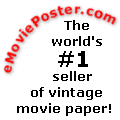DUOTONE
A poster is considered "duotone"
if it is printed using only two colors (usually black with another color
on a white background).
STUDIO-ISSUED/NSS DUOTONE MATERIALS
Duotone materials, particularly
one sheets, were initially introduced by major movie studios for the
purpose of providing promotional materials that were less costly to film
exhibitors than the full color posters. They were also great for cutting
advertising costs on low-budget films produced by both major and minor motion
picture studios. The studio-issued duotone materials were used extensively
on military bases.
These duotone materials usually feature
the same artwork as the full color counterparts, only in two colors. They
will normally include the same credit and print information, but will not
have the NSS number or
NSS tag line.
SECONDARY PRINTERS DUOTONE MATERIALS
Several independent printers introduced
a line of primarily duotone window cards as
an inexpensive alternative to the National Screen Service
materials. These duotone materials were particularly attractive to small
city and rural theaters. Window cards were made for mass distribution to
be placed in retail and office windows, posted on utility poles, nailed
to fences, etc.. As such, many theatres and movie exhibitors found these
duotone window cards to be extremely cost effective. The three most prominent
of these secondary printers were: (1) Benton
Card Company; (2) Hatch Card Company; and (3)
Globe Card Company.
The duotone window cards released by
the independent printers may contain the same artwork as the NSS window
cards, but they usually have their own unique artwork. The name of the printer
is normally printed somewhere in the bottom border of the window card.
ARE THEY COLLECTIBLE?
The value assessed to duotone materials
by most movie collectors depends upon which category the materials belong.
If a movie studio released duotone materials along with color versions of
the same paper, then the duotone versions will not command the same dollar
value as their color counterparts. Most collectors prefer the full color
over duotone, if both such versions exist. If, however, the duotone posters
are the only ones released with the particular film in question,
then the value of these materials would be based on standard "supply
and demand" theories.
Original duotone materials released by
independent or secondary printers are generally considered collectible.
However, most collectors do not consider them as desirable as the color
versions released either through NSS or the movie studios. Even when the
artwork and colors are identical, there can be major differences in the
prices for materials produced by independent printers and those issued through
NSS or the movie studios.





